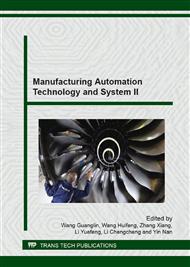[1]
Y.J. Wei: China Mechanical Engineering Vol. 17 (2006) No. 15 , p.1645–1648. (In Chinese).
Google Scholar
[2]
L.O. Hewko and T.R. Weber: Hydraulic Energy Storage Based Hybrid Propulsion System for a Terrestrial Vehicle, Energy Conversion Engineering Conference (1990) , p.99–105.
DOI: 10.1109/iecec.1990.716464
Google Scholar
[3]
Q.F. Wang, Y.T. Zhang and Q. Xiao: Chinese Journal of Mechanical Engineering Vol. 41 (2005) No. 12, p.135–140. (In Chinese).
Google Scholar
[4]
M. Paul and S. Jacek: Development and Simulation of a Hydraulic Hybrid Powertrain for Use in Commercial Heavy Vehicles. SAE Paper 2003–01–3370.
DOI: 10.4271/2003-01-3370
Google Scholar
[5]
A.J. Robyn, S. Paul and B. Steven: Physical System Model of a Hydraulic Energy Storage Device for Hybrid Powertrain Applications. SAE Paper 2005–01–0810.
DOI: 10.4271/2005-01-0810
Google Scholar
[6]
B. Wu, C.C. Lin, Z. Filipi, H. Peng and D. Assanis: Vehicle System Dynamics Vol. 42 (2004) , p.23–40.
Google Scholar
[7]
C.C. Lin, P. Peng and W. Jessy: IEEE Transactions on Control Systems Technology Vol. 6 (2003) , p.839–849.
Google Scholar
[8]
H. Sun, J.H. Jiang and X. Wang: Journal of Northeastern University Vol. 6 (2008) No. 29, p.248–252. (In Chinese).
Google Scholar
[9]
Y.J. Kim and Z. Filipi: Series Hydraulic Hybrid Propulsion for a Light Truck– optimizing the Thermostatic Power Management. SAE Paper 2007–24–0080.
DOI: 10.4271/2007-24-0080
Google Scholar
[10]
D. Peng, C.L. Yin and J.W. Zhang: Advanced Braking Control System for Hybrid Electric Vehicle Using Fuzzy Control Logic. SAE Paper 2006–01–3583.
DOI: 10.4271/2006-01-3583
Google Scholar
[11]
B. Simon, E. Christine, G. Edward and G.K. Markus: Hydraulic Hybrid Systems for Commercial Vehicles. SAE Paper 2007–01–4150.
Google Scholar
[12]
N.J. Shouten, M.A. Salman and N.A. Kheir: Control Engineering Practice Vol. 11 (2003) , p.171–177.
Google Scholar
[13]
S. Alev and B. Zafer: Engineering Applica-tions of Artificial Intelligence Vol. 19 (2006) No. 5, p.557–567.
Google Scholar
[14]
S. Hiroki, I. Shigeru and K. Eitaro: Study on Hybrid Vehicle Using Constant Pressure Hydraulic System with Flywheel for Energy Storage. SAE Paper 2004–01–3064.
DOI: 10.4271/2004-01-3064
Google Scholar
[15]
D.T. Qin, T. Deng, Y. Yang and Z.H. Lin: Chinese Journal of Mechanical Engineering Vol. 19 (2008) No. 5, p.618–624. (In Chinese).
Google Scholar


